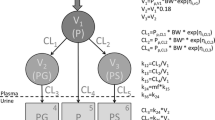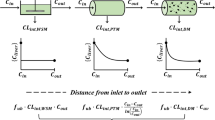Abstract
The formation of four major metabolites of propranolol by the liver was examined at steady state in three dogs that had undergone surgical portacaval transposition, following which injection of drug into the hindlimb delivers the total dose to the liver. Propranolol was infused directly into the liver via a hindlimb vein at dose rates ranging from 1.01 to 6.3 mg/min. In all dogs the formation of 4-hydroxypropranolol, α-naphthoxylactic acid, and propranolol glycol was saturable. Vmax and Km values were determined at steady state by relating the rate of excretion of each metabolite into bile and urine to the blood concentration of propranolol. The formation of propranolol glucuronide was a first order process. The use of a dog with a portacaval transposition has permitted development of a method to estimate, in vivo,the kinetic properties of enzymes responsible for hepatic first-pass metabolism of drugs.
Similar content being viewed by others
References
A. J. J. Wood, K. Carr, R. E. Vestal, S. Belcher, G. R. Wilkinson, and D. G. Shand. Direct measurement of propranolol bioavailability during accumulation to steady state.Br. J. Clin. Pharmacol. 6:345–350 (1978).
M-W. Lo, D. J. Efleney, S. M. Pond, B. M. Silber, and S. Riegelman. Lack of gastrointestinal metabolism of propranolol in dogs after portacaval transposition.J. Pharmacol. Exp. Ther. 221:512–515 (1982).
D. G. Shand and R. E. Rangno. The disposition of propranolol. I. Elimination during oral absorption in man.Pharmacology 7:159–168 (1972).
J. J. MacKichan, D. R. Pyszczynski, and W. J. Jusko. Analysis and disposition of low dose oral propranolol.Res. Commun. Chem. Pathol. Pharmacol. 20:531–538 (1978).
T. Suzuki, S. Isozaki, R. Ishida, Y. Saito, and F. Nakagawa. Drug absorption and metabolism studies by use of portal vein infusion in the rat. II. Influence of dose and infusion rate on the bioavailability of propranolol.Chem. Pharmacol. Bull. (Tokyo)22:1639–1645 (1974).
E. M. Bargar, U. K. Walle, S. A. Bai, and T. Walle. Quantitative metabolic fate of propranolol in the dog, rat, and hamster using radiotracer, high performance liquid chromatography, and gas chromatography-mass spectrometry techniques.Drug Metab. Disp. 11:266–272 (1983).
V. T. Vu and F. P. Abramson. The pathways of propranolol metabolism in dog and rat liver 10,000g supernatant fractions.Drug Metab. Disp. 8:300–304 (1980).
D. J. Effency, S. M. Pond, M-W. Lo, B. Silber, and S. Riegelman. A technique to study hepatic and intestinal drug metabolism separately in the dog.J. Pharmacol. Exp. Ther. 221:507–511 (1982).
M-W. Lo and S. Riegelman. Determination of propranolol and its major metabolites in plasma and urine by high-performance liquid chromatography without solvent extraction.J. Chromatogr. 183:213–220 (1980).
K. Perry and K. Kuhlmann. INTERPOLATE. InPublic Procedures, A Program Exchange for Prophet Users, H. M. Perry and J. J. Wood (eds.). Bolt Beranek and Newman (1979), pp. 10-9–10–12.
M. Rowland, L. Z. Benet, and G. G. Graham. Clearance concepts in pharmacokinetics.J. Pharmacokin. Biopharm. 1:123–136 (1973).
H. Baig and M. Reid-Miller. Prophet usage: Hyperbolic. InProphet Statistics, A User's Guide to Statistical Analysis on the Prophet System. T. Kush (ed.). U.S. Department of Health and Human Services, Public Health Service, National Institutes of Health (1980), pp, 6-40–6-43.
P. A. Routledge and D. G. Shand. Clinical pharmacokinetics of propranolol.Clin. Pharmacokin. 4:73–90 (1979).
B. Silber and S. Riegelman. Stereospecific assay for (−)- and (+)-propranolol in human and dog plasma.J. Pharmacol. Exp. Ther. 215:643–648 (1980).
B. Silber, N. H. G. Holford, and S. Riegelman. Stereoselective disposition and glucuronidation of propranolol in humans.Pharm. Sci. 71:699–704 (1982).
S. A. Bai, U. K. Walle, M. J. Wilson, and T. Walle. Stereoselective binding of the (−)-enantiomer of propranolol to plasma and extravascular binding sites in the dog.Drug Metab. Disp. 11:394–395 (1983).
T. Walle, U. K. Walle, D. R. Knapp, E. C. Conradi, and E. M. Bargar. Identification of major sulfate conjugates in the metabolism of propranolol in dog and man.Drug Metab. Disp. 11:344–349 (1983).
B. M. Silber, N. H. Holford, and S. Riegelman. Dose-dependent elimination of propranolol and its major metabolites in humans.J. Pharm. Sci. 72:725–732 (1983).
T. Walle and U. K. Walle. Stereoselective oral bioavailability of (+)-propranolol in the dog. A GC-MS study using a stable isotope technique.Res. Commun. Chem. Pathol. Pharmacol. 23:453–464 (1979).
Author information
Authors and Affiliations
Additional information
Supported in part by Grants GM 16496 and 26556 from the National Institutes of General Medical Sciences, National Institute of Health.
Deceased.
Rights and permissions
About this article
Cite this article
Lo, MW., Pond, S.M., Effeney, D.J. et al. Nonlinear formation of propranolol metabolites in dogs after portacaval transpositions. Journal of Pharmacokinetics and Biopharmaceutics 12, 401–412 (1984). https://doi.org/10.1007/BF01062665
Received:
Revised:
Published:
Issue Date:
DOI: https://doi.org/10.1007/BF01062665




